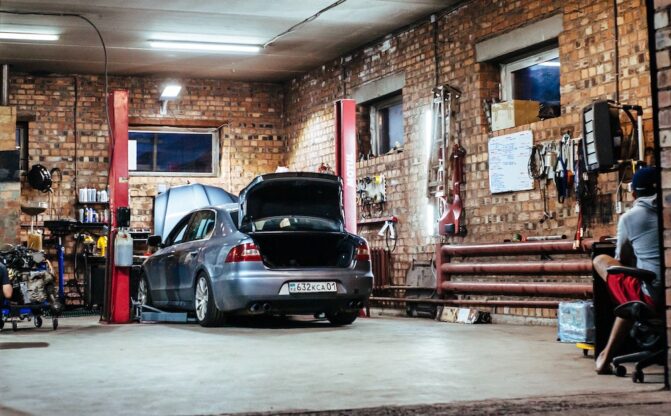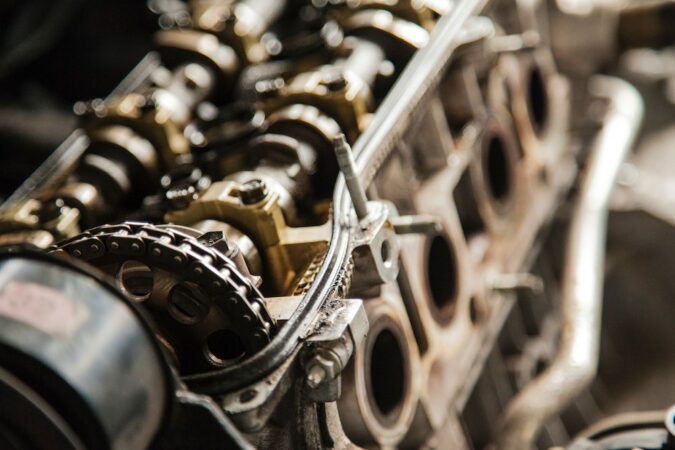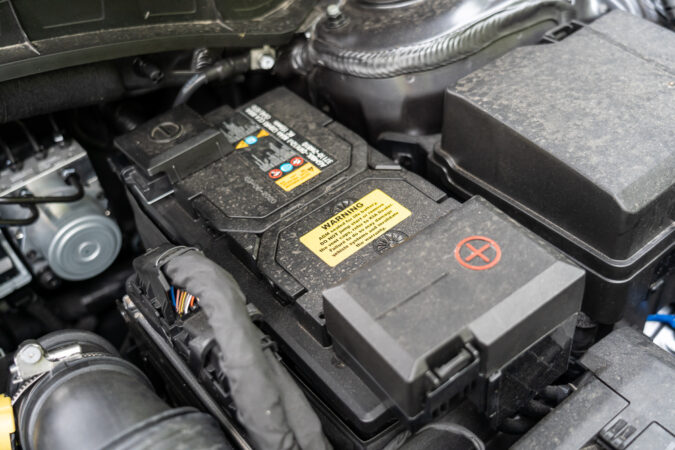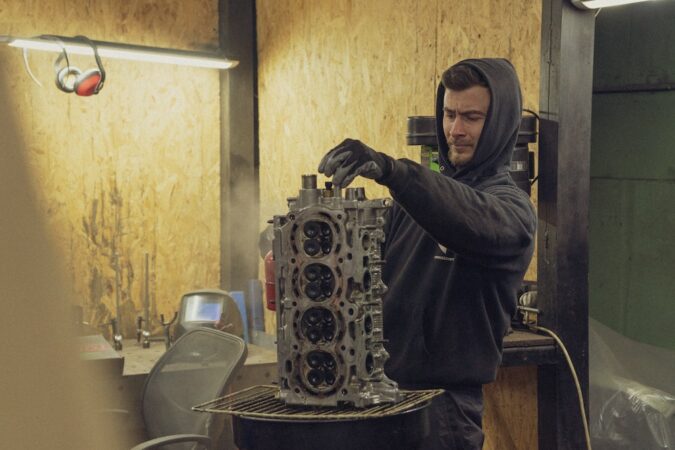A car stalling is when your car’s engine suddenly dies. It’s not a pleasant occurrence, but this post will help you learn what to do when your car stalls. We’ll also discuss the potential causes and you’ll get an idea of the repairs you might need to do if your car stalls. Let’s begin:
What To Do If Your Car Is Stalling
If your car stalls, don’t panic; panicking will not help anyone in this situation. If the car stalls while you’re driving along, here’s what you need to do:
- Don’t brake unless there’s a car or an obstacle in front of you. Instead, let the car coast until you can find a safe space to pull over. If possible, find a parking lot to stop which will give you a lot of space and away from danger.
- If not, stop on the side of the road where safe. Don’t forget to use your turn signals when you pull over.
- Once you pull over, engage the parking brake and turn on the hazard lights.
- Try restarting the car. Depending on the cause, you may be able to get the car running again and you may be able to get the car to the nearest repair shop.
- If the car won’t start, then call a towing service in your area. You can either tow your car to a repair shop or back home if you want to work on the car on your own.
If you happen to stall at a red light, turn on your hazard lights. Then push the car out of traffic so you can safely inspect the car or call for help. If the car won’t start again, then it’s best to call for a tow to get you back home or to the nearest auto repair shop.
Trying to troubleshoot the car on the side of the road can be dangerous. And even if you managed to stop at a parking lot, it’s best to do it at home since troubleshooting a car – especially a modern one – requires various tools and will take some time.
Potential Causes For Car Stalling
A car engine is very complex and there’s a myriad of potential causes for your car stalling. Here are the potential causes:
1. Battery System Issues
Your car has a battery that it uses to start the engine and power accessories when the engine is off. Over time, this battery will lose its ability to hold a charge to a point where it can no longer support the car.
The battery is charged by an alternator. This device runs on the engine’s serpentine belt and it charges the battery as you drive along as well as power electrical accessories. When the battery is dead, it will overwork the alternator to the point it can no longer support the car’s essential components and causes the engine to die.
Car batteries typically last between 1 – 2 years, although some expensive and heavy-duty ones may last up to three years if your car doesn’t have a stop-start system. If you’re due for a battery change, this might be the reason your car stalled.
If not, the battery may be dead because the alternator isn’t charging properly. In this case, you’ll need to either service or replace the alternator along with the battery.
2. Ignition System Issues
Your car’s engine runs by combusting the fuel and air mixture inside the engine cylinders. The engine uses an ignition system to create a spark in the cylinders and combust the mixture. This system consists of spark plugs and ignition coils which deliver power to the spark plugs. It will also have an ignition cable if your car happens to have a distributor-type coil.
Keep in mind that diesel engines don’t have an ignition system. The high compression design of diesel engines is enough to combust the fuel and air mixture on its own. So, if you own a diesel, you can skip this section.
Anyway, if one of these components fails, your engine won’t have the necessary spark to combust the fuel and air mixture. In most cases, this will cause your engine to misfire and lose performance. But in severe cases, it can also cause the engine to die out.
Both the spark plugs and ignition coils will wear out over time. Spark plugs usually last for about 25,000 miles depending on the quality while ignition coils usually last for 100,000 miles. If you’re due for a change, this might be the cause.
3. Air Intake System Issues
As mentioned, your car runs by combusting the air and fuel mixture inside the cylinder. So, your car has an air intake system that delivers air into the engine’s cylinders.
This system consists of many components, including the air intake tubing, Mass Air Flow (MAF) sensor, and the throttle body amongst others. If one or more of these components are faulty, the engine won’t get enough air and it can’t combust the fuel to keep the engine running.
The problem could be as simple as a dirty and clogged air filter. The system has a filter inside the box to filter out dust and debris and prevent them from getting into and damaging the engine. Over time, the filter can clog up and prevent enough air from entering the engine.
However, it may also be something more complicated like a faulty MAF sensor or a bad throttle body. These problems will also prevent your engine from getting enough air which leads to the car stalling.
4. Fuel System Problems
Along with air, your car needs fuel to burn. The fuel delivery system essentially consists of the fuel pump, lines, and fuel injector. If the pump or injector is faulty, or the fuel line is damaged, then your engine won’t get the fuel it needs.
Additionally, the engine also has a fuel filter that filters out dirt and debris from the fuel before it enters the engine. This filter needs to be changed around every 30,000 miles. If they clog up, then it will result in low fuel pressure and not enough fuel entering the engine.
5. Engine Timing Issues
All internal combustion engines have either a timing belt or chain. The timing belt/chain synchronizes the movement and timing of various moving parts in the engine by connecting the camshaft and crankshaft.
We won’t get into the details, the gist of it is that the movement and timing of your engine’s internal parts have to be synchronized, and that’s the job of the timing belt or chain.
Over time, the timing belt/chain will wear out, and eventually, the engine may desynchronize. This can result in the engine stalling, but worse, this can cause severe internal engine damage, and needless to say, those are very costly.
Timing belts usually last for about 60,000 miles. Meanwhile, timing chains usually last between 150,000 to 200,000 miles, although in some cars it may wear as early as 100,000 miles.
6. Internal Engine Damage
Another possible cause is damage to the internal components of the engine. This is more likely if you’re running an old car that hasn’t been maintained properly. Newer cars shouldn’t have damage to internal components unless it’s severely neglected.
Some potential problems include blown head gasket, damaged pistons or bad piston rings, or bent valves. But as mentioned, this is more likely in older cars or cars that are severely neglected.
Car Stalling: How To Diagnose
Diagnosing a stalling a car is not going to be easy. There are quite literally hundreds of components that can go wrong and cause the car to stall. The easiest way would be to check the battery system first:
1. Checking The Battery
So, how do you know if the battery is dead? Check electrical accessories in the car. Make sure the ignition key is in the ‘ACC’ position, and see if the radio, windows, or lights work. If they don’t work, then either your battery is dead or there’s an issue with the electrical system that’s preventing the flow of electricity.
The accessories may still work if the battery still holds a small charge. In this case, try starting the car and listen to how it cranks. If the crank is weak or the car doesn’t crank, then you probably have a weak battery. This may also be a starter motor issue, but this won’t have caused the engine to stall.
If the car cranks fine, this means there was something else causing the car to stall. You can also check the battery’s condition if you happen to have a multimeter with you:
If it happens to be a battery issue, you can get the car running again by jumpstarting the car. However, you will still need to replace the car’s battery afterward. Additionally, you’ll need to check whether or not your alternator is working. If the alternator is faulty, you’ll need to replace that as well. Otherwise, the new battery will die again very soon.
2. Scan The OBD System
If you’ve established that the battery is fine, then it’s likely a problem with one of the engine components, such as the ignition, air intake, and fuel system. If the problem lies with these engine components, you should see a check engine light on your dashboard.
Your car has an On-Board Diagnostic (OBD) system. When something is wrong with the engine, the car will register a trouble code in the OBD system which triggers the check engine light. You can then scan the OBD system and find the trouble code.
The trouble codes won’t tell you the exact cause, but they will let you know what’s wrong with the car and help to make it easier to diagnose. Here’s how to use an OBD scanner:
Keep in mind this method is for cars after 1996 with an OBD-2 system. Cars before 1996 had OBD-1 systems and they’re not universal. You’ll need to research further on how to use the OBD-1 system in your car’s specific make and model.
Anyway, once you find the trouble code, you can narrow down the possibilities and help you diagnose the problem. For example, the P0505 or P0506 codes mean that there’s either a vacuum leak or a problem with the idle air control valve (IACV).
Either way, both of these problems relate to the air intake system and cause a less-than-optimal air to fuel mixture which can cause the car to stall, particularly when idling.
There are thousands of these trouble codes. So, take note of the codes you see in the OBD scanner, and then check what the trouble code means and research what the potential causes are.
Car Stalling: What If I Don’t See A Check Engine Light?
It’s unlikely that an engine problem won’t trigger a check engine light, but it can happen. This is where it gets tricky, as this means you’ll have to troubleshoot on your own without the help of the OBD scanner.
We recommend watching the video above from ChrisFix if you have difficulties starting the car after it stalls. Or you can also read our guide on how to troubleshoot a car that cranks but won’t start. Chances are whatever’s preventing your car from starting, is the cause of your car stalling in the first place.
If you experience intermittent stalling, we recommend checking the fuel system. Intermittent stalling is usually caused by inconsistent and low fuel pressure, which can be caused by either a bad fuel pump or clogged fuel lines or filters.
Bottom line, troubleshooting a stalling car will be difficult and will take some time without the help of an OBD scanner. If you don’t see a check engine light, then we recommend taking your car to a trusted repair shop and having a professional mechanic troubleshoot the problem for you.
Car Stalling: Repair Cost Estimates
So, after troubleshooting and finding out the cause, you’re going to want to repair it to make sure your car doesn’t stall again in the future. Here are the repair cost estimates, depending on what you need to repair or replace:
1. Cost Estimate: If You Need A New Battery
Most car batteries cost between $50 to $250 depending on the type and quality. The labor cost of replacing the battery is usually included in the price, although some may charge as much as an extra $100 for the labor. You can easily replace the battery yourself to save money.
Keep in mind that you should check the alternator every time you change the battery. If the alternator isn’t charging properly, then the battery will go flat again very soon.
If you have a bad alternator, you’re going to have to either rebuild or replace it. Rebuilding an alternator usually costs between $50 – $150, while replacing an alternator costs between $350 – $500 including labor.
Speaking from experience, rebuilding an alternator is more of a short-term solution. There’s a chance the alternator will fail again within a year and you’ll need to replace them. If you have the budget, we recommend replacing rather than rebuilding the alternator.
2. Cost Estimate For Ignition System
As mentioned, the three main components in the ignition system that you may need to replace are the spark plugs, the ignition coils, and the ignition cables if you have a distributor-type ignition system.
Spark plugs are cheap to replace. A set of spark plugs are usually around $50 – $100 depending on the brand and quality. Although you may need to shell out more money if your engine has more than six cylinders as you need more spark plugs. The labor for a spark plug replacement is usually around $120 – $160 for most cars (while also taking into account how many spark plugs in a V8 and how to change spark plugs).
Meanwhile, the ignition coil is slightly more expensive. Whether you have a coil-on-plug system or a distributor-type ignition coil, it will set you back between $250 – $450 including labor. And if you need to replace the ignition cables, a set of them can cost anywhere between $80 – $300 depending on the make and model.
The good news is that the ignition system is relatively easy to work on and you can do it yourself to save some money. The video above shows how to replace the spark plugs and ignition coil in a coil-on-plug system.
A distributor-type coil isn’t too difficult to replace either. The difference is that you need to mark the connections in the ignition coil to make sure the ignition cables are connected to the correct cylinders. As long as you have a set of common hand tools, you should be able to do the job yourself.
3. Cost Estimate For Air Intake Problems
The most common air intake problem that can cause a car to stall are a clogged air filter, faulty MAF sensor, vacuum line leaks, and a bad idle air control valve. Here’s how much to fix them:
- A new air filter costs between $20 – $85, with another $40 – $85 for labor. However, replacing the air filter on your own is very easy: simply locate the air intake box, undo a few clips, open the air intake and replace the air filter inside it with a new one.
- MAF sensor costs about $300 on average to replace including labor. However, some cars may cost more than this. Replacing the MAF sensor usually isn’t too difficult and you can do it yourself to save money.
- A vacuum leak that happens at the vacuum line will cost between $50 – $100. However, a vacuum leak may happen in other parts such as at the EVAP system. Read our guide to vacuum leaks to learn more.
- The idle air control valve (IACV) is the likely culprit if your engine stalls when idling. The IACV controls airflow for the engine during idling, and a faulty IACV might prevent the engine from getting enough air. It costs between $150 – $520 to replace them.
4. Cost Estimate For Fuel System Issues
As mentioned, if you experience intermittent stalling, it’s likely to be a fuel system problem. Here are the estimates to replace various fuel system parts:
- A faulty fuel pump will cost between $290 – $590 to replace including labor.
- Fuel injectors are more expensive and cost between $600 – $750 to replace on average, including labor.
- Fuel filters on the other hand typically cost between $15 – $60 for the parts, but labor may bring the total cost to between $100 – $300 depending on the car’s make and model.
5. Cost Estimate For Timing Issue And Internal Damage
This is where it gets really expensive and prepare your bank accounts. If you have an engine timing issue, the timing chain or belt will likely need replacing. Timing belts are still relatively affordable, usually costing between $300 – $500.
However, timing chains can get expensive. It’s usually between $400 – $800. But some cars, especially cars with larger engines, can cost up to $2,000 to replace the timing chain. Replacing the timing chain won’t require specialized tools, but the complexity of the job means you won’t be able to do this at home unless you’re a professional mechanic.
Now, internal engine damage is where it gets really expensive. In most cases, you’ll need an engine rebuild or replace the engine entirely. An engine rebuild can cost anywhere between $1,500 – $4,500 depending on the parts you need to replace and engine complexity. Expect luxury and performance cars to cost even more.
Meanwhile, an engine replacement costs about the same. However, you can save money by getting a used engine – if you manage to find one for your car. They usually cost between $500 – $1,500. The downside is that these engines may not be in great condition, and the warranty is much more limited.
Since this is a major repair job, you’re unlikely to be able to do this yourself as it requires a lot of time, skill, and specialized tools. If you can’t afford the repair costs, then maybe it’s time to scrap your car.
Facts: Common Causes of Car Stalling and What to Do When it Happens
- Vehicle stalling can happen at different times, including when starting the car, coming to a stop, and when idling, and can be especially concerning when cruising at operating speeds.
- There is no singular cause for vehicle stalling; instead, multiple issues can lead to a stalling condition, requiring further diagnosis before a remedy can be found.
- Fuel system issues, charging system issues, spark-related issues, sensor issues, vacuum leaks, lockup of belt-driven accessories, timing issues, and transmission issues are common causes of the vehicle stalling.
- Stalling is cause for immediate concern and should be addressed as soon as possible, as it can compromise one’s safety if it occurs at cruising speeds.
- If a car stalls while driving, the driver should remain calm, apply the brakes at a steady and reasonable rate, and look for a safe place to pull over, such as the shoulder of the roadway.
- Once safely stopped, the driver should put the car in park (automatic) or neutral (manual) and set the emergency brake.
- If the source of the stalling cannot be easily identified and repaired roadside, the driver should call a wrecker to have the vehicle transported to a service facility.
- Stalling a manual transmission car is unlikely to cause any notable damage unless done repeatedly over several years, but is not ideal and should be avoided.
- Components such as a failing fuel pump, severe fuel leak, or an obstruction within the fuel system itself can cause a lack of fuel pressure/delivery, preventing an engine from achieving proper combustion and causing a stalling condition.
- Issues related to a vehicle’s throttle body or idle air control valve (IAC), faulty ignition coils, deteriorated distributor caps, and damaged rotor buttons can also induce a stalling condition by causing spark loss, which ignites the air/fuel mixture within each cylinder.
Car Stalling: In Conclusion
Internal combustion engines are incredibly complex with hundreds of different components that work together to keep them running. As such, there’s a lot of possibility on why your car stalled.
Our advice is to check the battery system first as that’s the easiest one to diagnose. If the battery system is fine, you’re likely looking at an engine problem in which case you will probably see a check engine light illuminating.
This will make the diagnosing job a lot easier, as you can use an OBD scanner to pull the trouble codes from the OBD system. These codes will narrow down the possibilities and it will be much easier for you to diagnose the problem.
Once you find the problem, replace or repair the parts as necessary to prevent further problems with your engine. Hopefully, this has been a helpful guide and will help you prevent your car from stalling again in the future. Good luck!





